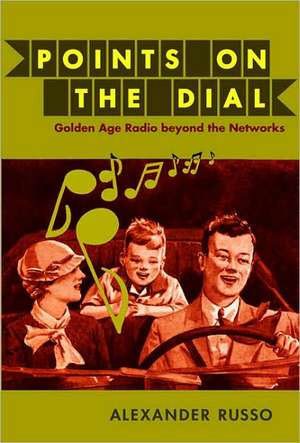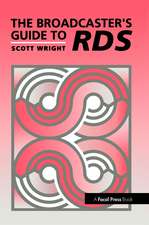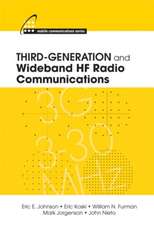Points on the Dial – Golden Age Radio beyond the Networks
Autor Alexander Russoen Limba Engleză Paperback – 9 feb 2010
Preț: 213.24 lei
Nou
Puncte Express: 320
Preț estimativ în valută:
40.80€ • 42.60$ • 33.77£
40.80€ • 42.60$ • 33.77£
Carte tipărită la comandă
Livrare economică 05-19 aprilie
Preluare comenzi: 021 569.72.76
Specificații
ISBN-13: 9780822345329
ISBN-10: 0822345323
Pagini: 292
Ilustrații: 11 illustrations
Dimensiuni: 156 x 230 x 22 mm
Greutate: 0.41 kg
Ediția:New.
Editura: MD – Duke University Press
ISBN-10: 0822345323
Pagini: 292
Ilustrații: 11 illustrations
Dimensiuni: 156 x 230 x 22 mm
Greutate: 0.41 kg
Ediția:New.
Editura: MD – Duke University Press
Recenzii
Points on the Dial is an important book, smart and forcefully argued. Alexander Russo makes a fresh and distinctive contribution to radio studies and to media history and analysis by challenging the network-centric history of radio and bringing the role of regional radio to the fore. His discussion of regional programming gambits is new and fascinating, as is his account of the rise of spot advertising.Susan J. Douglas, author of Listening In: Radio and the American ImaginationOffering fascinating arguments based on a wealth of excellent research, Alexander Russo fills in the history of radio broadcasting in the United States. He reveals the diversity of practices obscured until now by scholars focus on the national networks.Michele Hilmes, author of Radio Voices: American Broadcasting, 19221952
Notă biografică
Alexander Russo is Assistant Professor of Media Studies at The Catholic University of America.
Textul de pe ultima copertă
"Offering fascinating arguments based on a wealth of excellent research, Alexander Russo fills in the history of radio broadcasting in the United States. He reveals the diversity of practices obscured until now by scholars' focus on the national networks."--Michele Hilmes, author of "Radio Voices: American Broadcasting, 1922-1952"
Cuprins
Acknowledgments ix
Introduction: Narratives of Radio's Geographies 1
1. The Value of a Name: Defining and Redefining National Network Radio 17
2. "The Lord is my Shepard, I shall not want": Regional Networks as Sites of Community and Conflict 47
3. Brought to You via Electrical Transcription: Sound-in-Disc Recording and the Perceptual Aesthetics of Radio Distribution Technologies 77
4. On the Spot: The Spatial and Temporal Flow of Spot Broadcasting 115
5. People with Money and Go: Locating Attention in the Human Geography of Radio Reception 151
Conclusion: Open-End Game: The Legacy of Spots, Representatives, and Transcriptions 184
Notes 191
Bibliography 241
Index 257
Introduction: Narratives of Radio's Geographies 1
1. The Value of a Name: Defining and Redefining National Network Radio 17
2. "The Lord is my Shepard, I shall not want": Regional Networks as Sites of Community and Conflict 47
3. Brought to You via Electrical Transcription: Sound-in-Disc Recording and the Perceptual Aesthetics of Radio Distribution Technologies 77
4. On the Spot: The Spatial and Temporal Flow of Spot Broadcasting 115
5. People with Money and Go: Locating Attention in the Human Geography of Radio Reception 151
Conclusion: Open-End Game: The Legacy of Spots, Representatives, and Transcriptions 184
Notes 191
Bibliography 241
Index 257
Descriere
A historical examination of the various forces that transformed radio into the locally-based, musically-oriented medium that has dominated the airwaves since the introduction of the television.






















